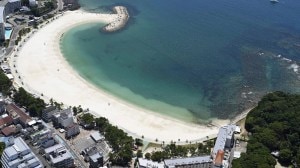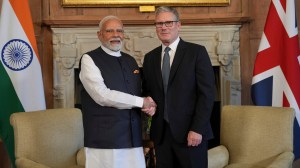Petroglyph found in Konkan added in UNESCO heritage sites tentative list
The petroglyphs in Ratnagiri region are also known as katal shilpa and believed to be nearly 20,000 years old.
 An elephant carved on the stone surface is more or less a life-size depiction of the animal. (Express)
An elephant carved on the stone surface is more or less a life-size depiction of the animal. (Express)THE PETROGLYPHS of Konkan region, spread across Maharashtra and Goa, are among the three Indian attractions that have been added to the Tentative List of UNESCO (United Nations Educational, Scientific and Cultural Organisation) World Heritage Sites.
The other two Indian sites are Jingkieng Jri, the living root bridge in Meghalaya, and Sri Veerabhadra Temple in Andhra Pradesh’s Lepakshi. Petroglyphs or Geoglyphs are a form of rock art, and comprise images drawn by removing part of a rock surface on the ground by incising, picking, carving or abrading.
Ratnagiri district is believed to have more than 1,500 petroglyphs spread across over 70 sites. The carvings are in the shape of human figures, birds, animals and geometric forms, though they vary in shape and size from site to site.
The petroglyphs in Ratnagiri region are also known as katal shilpa and believed to be nearly 20,000 years old. The Tentative List in UNESCO mentions seven sites with petroglyphs in Ratnagiri district — Ukshi, Jambharun, Kasheli, Rundhe Tali, Devihsol, Barsu and Devache Gothane, one in Sindhudurg district –Kudopi village, and nine sites at Pansaimol in Goa.
The Maharashtra government, through its Tourism and Cultural affairs Department, has now started the process of preparing a final dossier of these prehistoric rock art sites. The dossier will be sent the Archaeological Survey of India, which will then present it to UNESCO in a bid to secure the tag of a World Heritage Site.
Dr Tejas Garge, director of Maharashtra Archaeology Department, said they have started the process to appoint an agency to prepare the dossier, which will include several interesting aspects of the site.
Over the last few years, Sudhir Risbud of Ratnagiri-based Nisarga Yatri Sanstha and his team have undertaken a campaign to find and preserve petroglyphs in Konkan region.
They have, so far, discovered nearly 1,700 petroglyphs from more than 72 villages. Their team alerted authorities about the rich abundance of petroglyphs in the area.
“It is a proud moment for the whole team of Nisarga Yatri as the sites have been added to the Tentative List of UNESCO. We hope that it is recognised as a World Heritage Site,” said Risbud.












